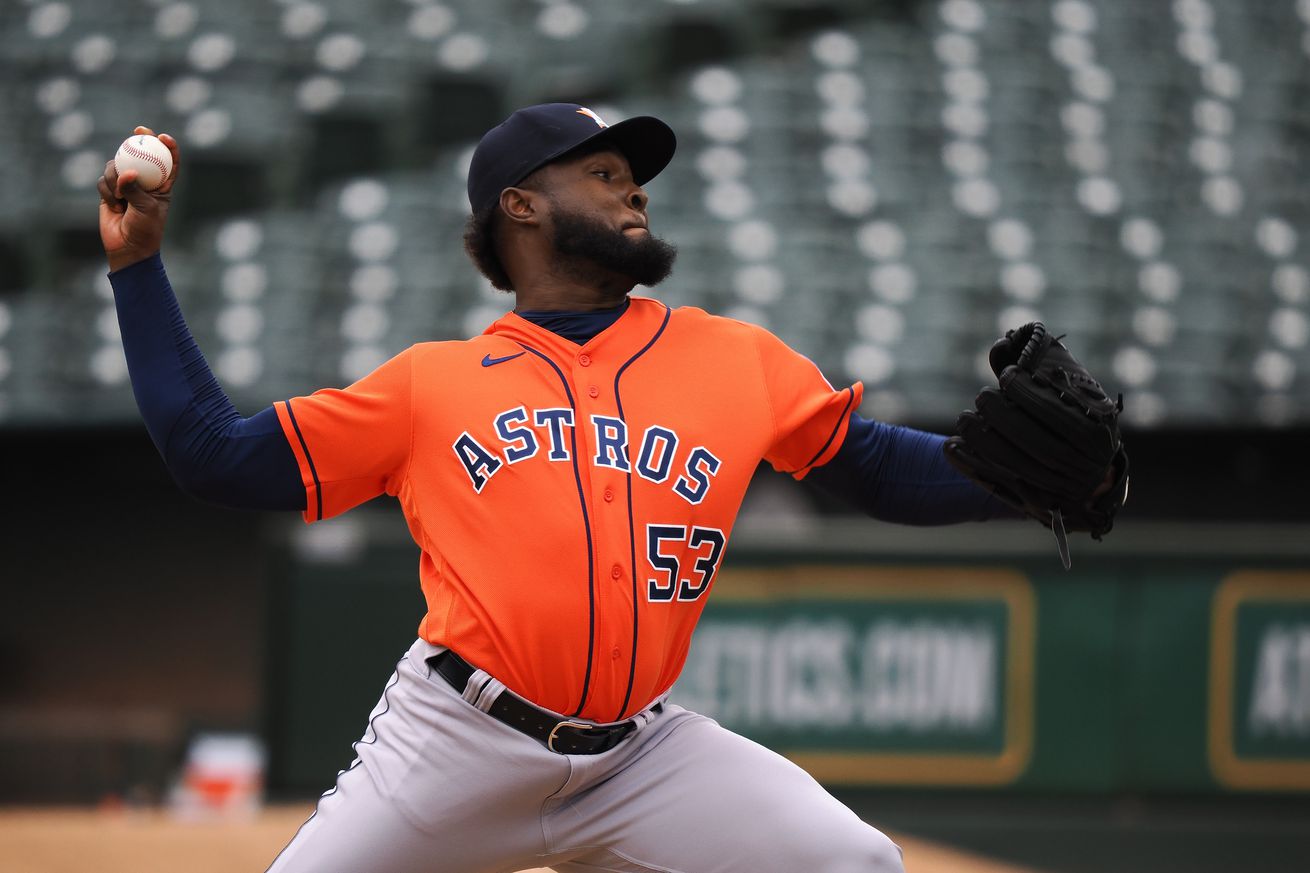
I wrote here a couple of weeks ago about how Cristian Javier has a strikeout problem. This is a sentence nor a topic I expected to write about even a few months ago. After all, Javier’s 32.1% strikeout rate from 2021 through 2022 appeared sustainable. While fluctuations are possible and expected, a sizeable variation in either direction didn’t seem likely. Cue the surprise behind his current rate of 22.9%, which is a nearly 10% decline. Unfortunately, his latest start with only one strikeout compared to five walks in 2 1⁄3 innings only intensified my concerns. Ironically, what was my primary concern with Javier about two years ago — his walk rate — has improved dramatically. If you’re looking for a reason why he still has favorable results this season, that development is a key reason why.
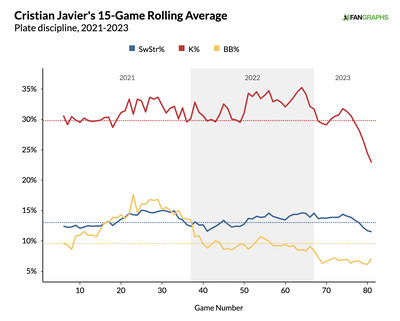
So, what is plaguing Javier specifically now? As you can tell from the blue line above, Javier’s swinging strike rate, which has a strong correlation to strikeouts, has dipped a bit. When I first researched Javier’s issues his decline in this area (-2.3%) was the eight-highest among all pitchers with at least 125 innings last season and 50 innings this season. Whereas he had a whiff rate in the 82nd percentile last season, it is now in the 57th percentile. Of his primary two pitches — four-seam fastball and slider — both have declined in terms of whiffs, down from 27.3% and 39.4% in 2022 to 25.8% and 30.3% this season. Even by pitch modeling — Stuff+ in this situation — Javier’s pitches are less impressive than they have been in past seasons.
Stuff+
- 2022, Four-Seam: 120
- 2023: Four-Seam: 93
- 2022, Slider: 119
- 2023: Slider: 103
There a couple of reasons why I think Javier’s pitches, especially his best and most frequently used, are struggling compared to past seasons: Velocity and release points. Javier, for example, has never possessed overwhelming velocity. Even during his best season to date in 2022, his four-seam fastball averaged around 93.8 MPH, good for 292 out of all pitchers with at least 250 as a qualifier. It is the kind of fastball that he can’t use in the heart of the zone on a consistent basis and expect good results, unlike some pitchers who can rely more on their velocity to bail them out. But Javier compensates for this issue by how he throws it, which is with plenty of backspin and daring hitters at the top of the zone. With this backspin in addition to the angle (Vertical Approach Angle, or VAA) involved, it creates the illusion that his fastball is rising. In other words, Javier’s four-seam drops less as it traverses the strike zone, hence why it gives the illusion why it is rising.
Unfortunately for Javier, he has been less successful in replicating his illusionary magic in 2023. Following a season where he limited opposing hitters to a .183 batting average and .326 slugging percentage against his fastball, Javier’s numbers have regressed with a .244 batting average and .416 slugging percentage in 2023. The same goes for his slider. A quick search points out a decline in velocity like a sore thumb for his fastball.
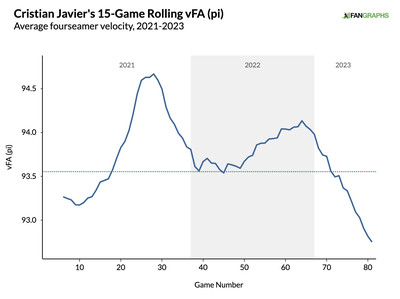
As with most pitchers, any velocity decline this pronounced is concerning, especially it has yet to rebound in any meaningful way. Whereas he averaged about a little over 94 MPH by the end of last season, he average four-seam velocity has decreased to below 93 MPH. However, one would think Javier could mask this decline a bit better than most with how he throws. I mean, it isn’t farfetched when you hear stories about how a 93 MPH four-seamer looks more like a 100 MPH offering based on the backspin he creates, the angle of approach, and the mechanics of his delivery. That said, it sometimes doesn’t take much for a velocity decline to have detrimental effects and it is one reason why Javier has become increasingly mortal.
But like many things in life, it is rarely only a single issue at play. In this instance, we’re also seeing a change in how Javier throws his pitches. As noted earlier, it matters greatly how Javier’s pitches, specifically his four-seamer, approaches the plate. By release points, we can clearly see a change in how Javier throws his most frequently used pitches on both the vertical and horizontal plane.
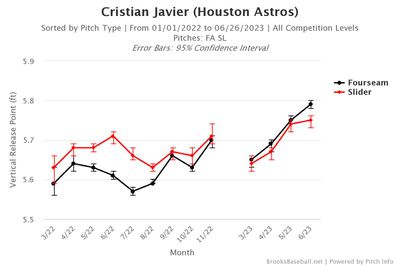
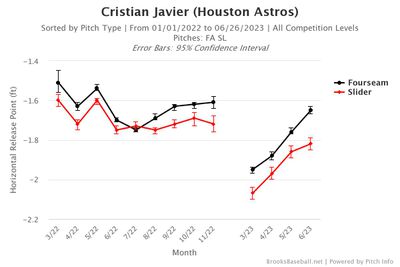
There is a difference in where Javier is releasing the ball this season. The vertical release point, in particular, is rather worrisome considering its importance to how his fastball operates. In his case, the less drop Javier’s four-seamer has upon its approach to home plate, the better. Any alteration to his release point could impact the deception he relies heavily upon. I think we’re seeing the ramifications of such a change, as shown below by VAA AA (Vertical Approach Angle Above Average). If you’re interested in learning more about VAA, I highly recommend reading this post by Alex Chamberlain in addition to his own dashboard where you can find this information. The excerpt below from his article detailing how to interpret VAA AA and what that could mean.
For Javier in 2022, he had a VAA AA of 0.55 degrees, which, by using Chamberlain’s explanation above, was flatter than average. Remember that a key part of Javier’s success with his four-seamer hinges on how it approaches the plate. The flatter, the better. However, in 2023, Javier’s VAA AA is currently 0.30 degrees, indicating that his four-seam fastball is not nearly as flat as it was last season or in 2021 when it was 0.48 degrees above average. With Javier adjusting his release point higher, his fastball has lost some of its deception and is dropping a bit more as it approaches home plate. Plus, his four-seam spin rate has gradually decreased this season to about 2243 RPM compared to 2354 RPM in 2022. It is also apparent that these issues are bleeding into Javier’s slider usage and how it is behaving. With his best two pitches operating differently, and not in a good way, it isn’t a surprise to see his overall results somewhat fade.
By primarily throwing a four-seam and slider over 90% of the time, Javier is heavily reliant on those two pitches operating efficiently to have success. One could argue this is where a lack of a dependable third pitch is a detriment to Javier. But I have my doubts a quality third offering would help much in this case, especially if he is indeed not a hundred percent physically. In any case, I’ll keep a close watch on Javier’s velocity and release points going forward. If he has a rebound any time soon, I have a feeling it would have to come from one or both of those areas trending back in the other direction. But it is becoming increasingly clear something isn’t quite right with Javier. The question I have is whether his decline in velocity is influencing the adjustment to his release points, or vice versa. If an undisclosed injury or some sort of discomfort are involved, then that would at least explain the issues at play. Speculation, yes, but it is worth mentioning.